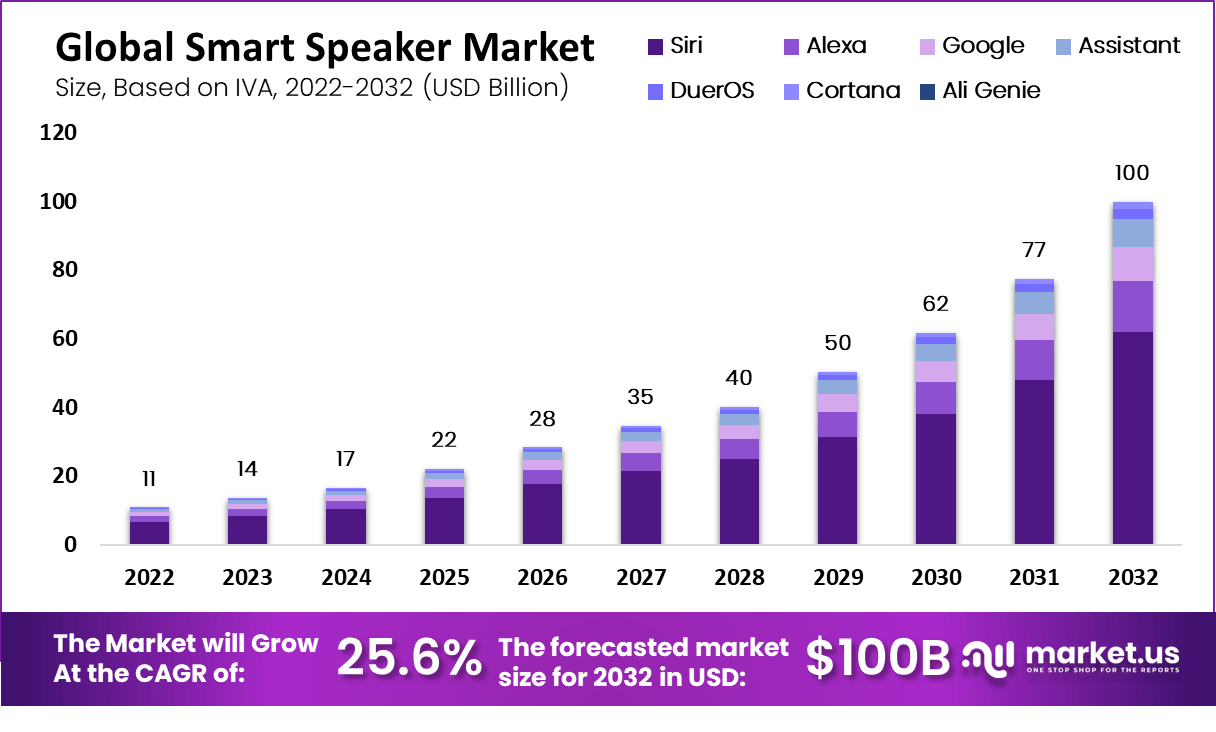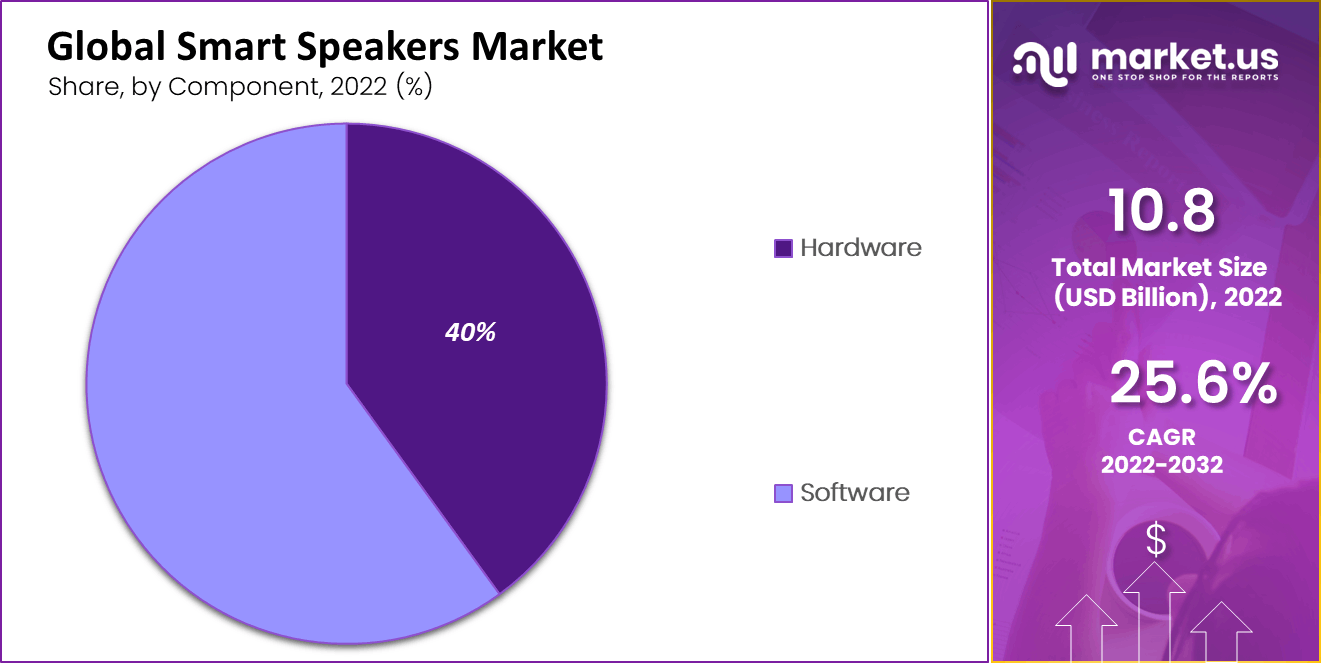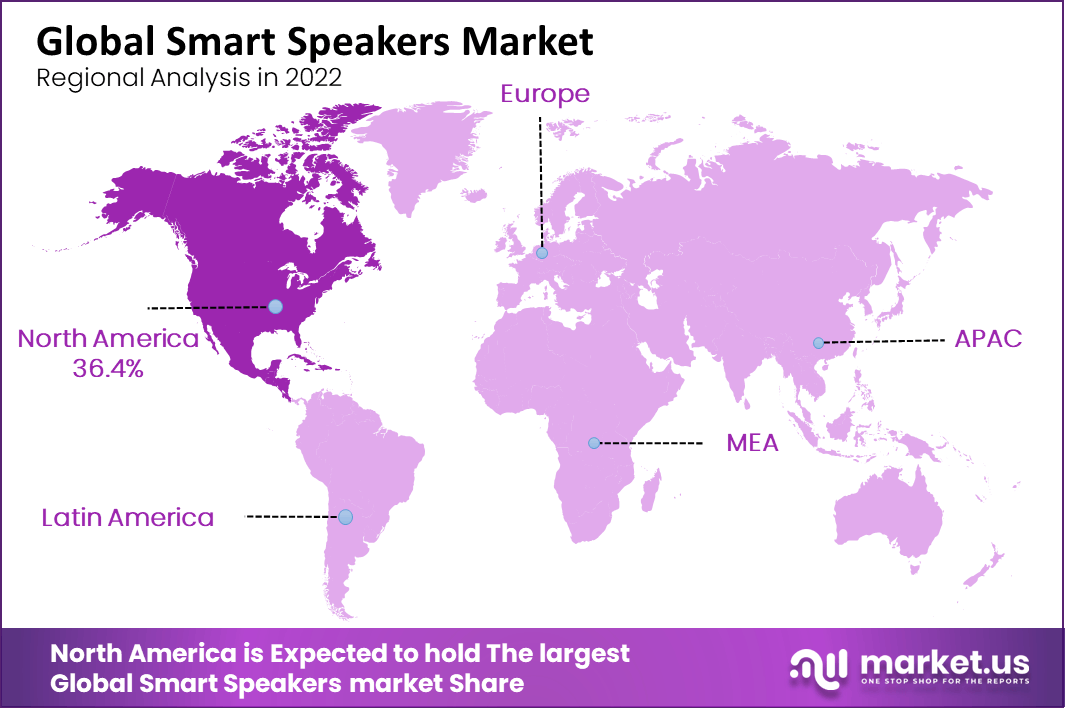Global Smart Speakers Market By Intelligent Virtual Assistant (IVA) (Siri, Alexa, Google Assistant, DuerOS, Cortana, Ali Genie, and Others), By Component (Hardware and Software), By Application (Smart Home, Smart Office, and by Consumers), By Region and Companies - Industry Segment Outlook, Market Assessment, Competition Scenario, Trends, and Forecast 2023-2032
- Published date: Oct 2023
- Report ID: 51895
- Number of Pages: 331
- Format:
- keyboard_arrow_up
Quick Navigation
Report Overview
The Global Smart Speaker Market size is expected to be worth around USD 100 Billion by 2032 from USD 10.8 Billion in 2022, growing at a CAGR of 25.60% during the forecast period from 2023 to 2032.
The central control hubs for many smart home functions, including entertainment, query resolution, online surfing, and so on, are voice-enabled virtual intelligent assistants known as smart speakers. Along with the increasing popularity of smart home technology, the prevalence of these smart speaker devices in homes throughout the globe has gradually increased.
Shortly, demand for the product is anticipated to increase due to the growing demand for speaker systems in residential applications. A few of the important factors anticipated to provide market opportunities for major competitors include the proliferation of smart home products, the development of artificial intelligence, and the expansion of display-based technologies.
Additionally, major market rivals are attempting to expand their business divisions internationally. In addition, the COVID-19 pandemic has increased the demand for smart speakers across the globe. Deep neural networks, machine learning, and other developments in AI technology are leading to an increase in virtual assistants.

Driving Factors
The increasing popularity of display devices contributes to the expansion of the market.
The increase in the manufacturing of consumer electronics and the growing demand for wireless connectivity are the main factors supporting the growth of the smart speaker market. Smart speakers with local voice support have huge growth potential in technologically advanced countries. With evolving technology such as speed internet, social networking, online content streaming, and video calling capabilities, industry leaders are increasingly shifting to display their base devices.
Additionally, major manufacturers offer a variety of products for intelligent display devices, automated, cost-effective customer care products, audio products, automation products, and Display-enabled gadgets, including Echo Show 5, Facebook Portal, Nest Hub (2nd Gen), Touch Screen Speaker, Smart Display, Link View and so on. These products work on intelligent voice assistance and are regularly updated and improved in response to customer feedback.
Connected solutions in smart homes are rapidly developing due to homeowners’ continued need for a convenient and comfortable lifestyle. With internet connectivity and the ability to control household products through mobile devices, customer interest is shifting to smart products. With these advantages, people in both technologically advanced and emerging regions are rapidly migrating to smart speakers. The growth of smart home devices is expected to drive the growth of smart speakers with virtual assistants in the coming years.
Restraining Factors
Issues related to data breaches
Smart homes with integrated user personal data are increasingly using voice assistant-capable smart speakers. The unintended activation of smart speakers by voice commands encoded in websites or television advertising is one of the main worries of users of smart speakers.
The majority of smart speakers can connect to any local network and any other device on that network, changing the smart speaker’s settings or conducting a factory reset without the user’s consent. To avoid such hazards, a secure local network and a strong account password are necessary.
Additionally, smart speakers are connected to other smart devices that are usable by other people, such as smartphones, smart locks, TVs, and radios. Some smart speakers allow voice purchasing, so someone else can utilize assistance to place an online item. A smart speaker can also be activated with a one-click order if it is connected to an Amazon Prime account. Users must therefore safeguard their settings and keep an eye on their notifications.
Growth Opportunities
Increasing response from customers regarding technologically advanced products.
With a growing market and increasing customers, spending on technologically advanced or smart devices that are portable, easy to carry, easy to handle, and well-built quality has forced the manufacturers to include voice assistance and voice commands in the speakers. There has been enormous demand for multifunctional, high-speed, easy-to-use smart speakers.
The development of wireless 5G infrastructure and development in natural language processing (NLP) has opened many doors in developing nations across the globe. NLP is an artificial intelligence that allows the customer to give a command to the smart speaker
Trending Factors
Introduction of artificial intelligence technology in the smart speakers.
NLP is an artificial intelligence that allows the customer to give a command to the smart speaker. AI gives major advantages in making conversational capabilities with natural processing language. These advanced technologies are helping to market the growth of smart speakers. Smart speaker manufacturers are increasingly focused on product innovation and differentiation as they are steadily moving toward consolidation through mergers & acquisitions, joint ventures, and collaborative partnerships. Such trends are currently being witnessed in this market, thereby bolstering the demand for these products in the process.
The area of Bluetooth connectivity has seen various innovations to further improve quality and privacy. For example, in March of this year, Sonos updated his Bluetooth speaker and removed the mic from his original Roam speaker. In other words, the user does not use voice control or manage other smart home devices. The increasing trend of human-machine interaction and the widespread automation of household chores are increasing the demand for our products.
In addition, several major players have invested in research and development (R&D) activities to launch innovative smart speakers with advanced features, functionality, and compatibility with all smartphones to expand their product portfolios. And gain a competitive advantage. In addition, the market is driven by recent advancements in audio and wireless technology and increasing consumer willingness to try new products.
Other factors, such as increasing penetration of Internet of Things (IoT) technologies, increasing sales of consumer electronics, increasing use of smart devices, and easy product availability through online and offline retail channels, are also contributing to the market growth.
IVA Analysis
Alexa is dominating this market.
Based on IVA, the global smart speaker market is segmented into Siri, Alexa, Google Assistant, DuerOS, Cortana, Ali Genie, and others. Alexa-enabled speakers are making a big contribution to this market due to the range of smart speakers and smart devices available and the compelling features they offer.
Siri from Apple is largely used by a wide audience of younger age groups, with 60% of those between 18 and 24 using it. On the other side, voice assistant users who are 35 and older are far more likely to utilize Alexa.
Component Analysis
The software segment dominates over the hardware segment in the Smart Speakers Market.
The software segment has a competitive advantage over the hardware segment. The software segment shares a major market size than the hardware segment due to Amazon, Google, Apple, and Others offering regular updates to the customers, which helps the software segment of the smart speaker to take an edge ahead hardware segment.
Echo, Dot, Amazon Smart Plug, and Echo Auto are different software versions of Alexa devices. The cheaper version of the Amazon Echo speaker is also called 2022’s best and smartest version of the speaker. The market for the Hardware segment falls short of competing with the software segment due to the decrease in the demand for hardware components which are processors, memory, mic, and others. Rather than buying hardware components of the smart speaker, customers go with buying a new one.
Application Analysis
Smart home takes the largest market share.
Depending on the application, the market is divided into a smart home, a smart office, and a consumer. According to 2022 data, smart home has 102.5 million new and enthusiastic users worldwide. The number is higher than that of smart offices so the smart home will become a large and growing market segment.
The smart home is poised to have the highest segment share in the market. Smart home gadgets such as smart appliances, security cameras, smart locks, smart lighting, and smart TVs are becoming increasingly popular among consumers. Moreover, this type of speaker acts as a one-stop shop and control center for all your smart devices, convenient to manage and control remotely. For example, Xiaomi is trying to establish an artificial intelligence system that uses the speaker as a control center to connect other products.

Key Market Segments:
Based on IVA
- Siri
- Alexa
- Assistant
- DuerOS
- Cortana
- Ali Genie
- Others
Based on Component
- Hardware
- Software
Based on Application
- Smart Home
- Smart Office
- Consumers
COVID-19 Impact Analysis
The COVID-19 outbreak positively impacted the smart speakers market growth through an increase in sales of smart homes.
COVID-19 has been impacting lives around the world in many ways. Market conditions have changed significantly. The global smart speaker market is having a major impact of the pandemic on all countries, regions, markets, and people.
Newly launched projects experienced a decline in market demand. Global factories operating in different geographical locations are also struggling to integrate new products as lockdown enforcement forces workers to stay home.
Economic uncertainties and work-from-home caused by the pandemic have increased the usage of speakers and other appliances for everyday tasks, including turning on and off lights, timers, music, and many other works that have further elevated the market.
Regional Analysis:
North America has seen tremendous growth in smart speakers.
North America shares a major market size in the smart speaker market with 36.4%. In terms of revenue and market owing, North America has a strong presence of early suppliers and adopters of major smart speakers.
The receptivity of customers to new technologies is also pushing manufacturers to develop new and advanced products in the region. However, the North American market is expected to be overtaken by Asia-Pacific to become the largest and most profitable market by 2025.
Asia Pacific is expected to hold a significant share of the global smart speaker market. Her three most important countries in the region include China, India, and Japan. Countries such as Japan and China have different manufacturers of smart speakers.
The market is growing with the increasing adoption of smart homes with smart devices such as smart speakers. Additionally, smart city projects in India and China are likely to act as drivers of market growth.
Major European players are increasingly turning to smart home speakers. Development of digital technology in this region with a significant growth rate. In South America and the Middle East/Africa regions, the acceptance of smart and wireless speakers is fuelled by the increasing acceptance of digital technology.

Key Regions and Countries Covered in this Report:
- North America
- The US
- Canada
- Mexico
- Western Europe
- Germany
- France
- The UK
- Spain
- Italy
- Portugal
- Ireland
- Austria
- Switzerland
- Benelux
- Nordic
- Rest of Western Europe
- Eastern Europe
- Russia
- Poland
- The Czech Republic
- Greece
- Rest of Eastern Europe
- APAC
- China
- Japan
- South Korea
- India
- Australia & New Zealand
- Indonesia
- Malaysia
- Philippines
- Singapore
- Thailand
- Vietnam
- Rest of APAC
- Latin America
- Brazil
- Colombia
- Chile
- Argentina
- Costa Rica
- Rest of Latin America
- Middle East & Africa
- Algeria
- Egypt
- Israel
- Kuwait
- Nigeria
- Saudi Arabia
- South Africa
- Turkey
- United Arab Emirates
- Rest of ME
Amazon has been dominating the market by using various strategies.
Amazon shares major market size through strategies of reducing the price of old products and launching a new product in the market. Amazon shares 22.5% of the smart speaker’s size.
Amazon has been coming up with a wide range of smart speakers to attract customers with Alexa, echo, and other products. Amazon has been a trendsetter in the market, leading in innovation and technology. Amazon has collaborated with companies such as BMW and Microsoft for growth in the smart speaker market.
Key companies such as Apple, Inc., Alphabet Inc., Tmall Genie, Sonos One, Bose Corporation, Xiaomi, Panasonic SC-GA10, Samsung Electronics Co. Ltd., JBL Link 20, Sonas Beam, Google Home Mini, Insignia Voice, AliGenie, DuerOS, SKT NUGU, NaverClova, and Kakaoa are some of the additional market players in the market.
Key market players are developing speakers integrated with AI and more. Moreover, increasing competition in the market forces major market players to focus on acquisition strategies to consolidate their positions.
Market Key Players:
- Amazon Inc.
- Apple Inc.
- Alphabet Inc.
- Tmall Genie
- Lenovo Group Ltd.
- Sonos one
- Bose Corporation
- Xiaomi Inc.
- Sonas Beam
- AliGenie
- DuerOS
- Others
Recent Developments:
- In May 2022, Apple announced that it plans to launch a new version of its HomePod smart speaker in late 2022 or early 2023. In July 2022, Xiaomi launched its second-ever smart speaker.
- In 2020 – Xiaomi introduced its first smart speaker in the market with Google Assistant. This technology can converse in Hindi and English. In July 2022, Xiaomi launched its second-ever smart speaker with big upgrades to the previous version.
Report Scope:
Report Features Description Market Value (2022) US$ 10.8 Bn Forecast Revenue (2032) US$ 99.9 Bn CAGR (2023-2032) 25.6% Base Year for Estimation 2022 Historic Period 2016-2022 Forecast Period 2023-2032 Report Coverage Revenue Forecast, Market Dynamics, COVID-19 Impact, Competitive Landscape, Recent Developments Segments Covered By Intelligent Virtual Assistant (IVA)- Siri, Alexa, Google Assistant, DuerOS, Cortana, and Ali Genie; By Component – Hardware and Software; By Application – Smart Home, Smart Office, and Consumers. Regional Analysis North America – The US, Canada, & Mexico; Western Europe – Germany, France, The UK, Spain, Italy, Portugal, Ireland, Austria, Switzerland, Benelux, Nordic, & Rest of Western Europe; Eastern Europe – Russia, Poland, The Czech Republic, Greece, & Rest of Eastern Europe; APAC – China, Japan, South Korea, India, Australia & New Zealand, Indonesia, Malaysia, Philippines, Singapore, Thailand, Vietnam, & Rest of APAC; Latin America – Brazil, Colombia, Chile, Argentina, Costa Rica, & Rest of Latin America; the Middle East & Africa – Algeria, Egypt, Israel, Kuwait, Nigeria, Saudi Arabia, South Africa, Turkey, United Arab Emirates, & Rest of MEA Competitive Landscape Amazon Inc., Apple Inc., Alphabet Inc., Tmall Genie, Lenovo Group Ltd., Sonos One, Bose Corporation, Xiaomi, Sonas Beam, AliGenie, DuerOS., and Others. Customization Scope Customization for segments, region/country-level will be provided. Moreover, additional customization can be done based on the requirements. Purchase Options We have three licenses to opt for: Single User License, Multi-User License (Up to 5 Users), Corporate Use License (Unlimited User and Printable PDF) Frequently Asked Questions (FAQ)
What is the CAGR of Global Smart Speaker Market?The Global Smart Speaker Market CAGR is of 25.60% during the forecast period from 2023 to 2032.
What was the Size of Smart Speaker Market in 2022?The Global Smart Speaker Market size was USD 10.8 Billion in 2022, growing at a CAGR of 25.60%.
What is the Smart Speaker Market growth during the forecast period?The Global Smart Speaker Market size is expected to be worth around USD 100 Billion by 2032 from USD 10.8 Billion in 2022.

- Amazon Inc.
- Apple Inc. Company Profile
- Alphabet Inc.
- Tmall Genie
- Lenovo Group Ltd.
- Sonos one
- Bose Corporation
- Xiaomi Inc.
- Sonas Beam
- AliGenie
- DuerOS
- Others
- Nestlé S.A Company Profile
- settingsSettings
Our Clients
| Single User $4,599 $3,499 USD / per unit save 24% | Multi User $5,999 $4,299 USD / per unit save 28% | Corporate User $7,299 $4,999 USD / per unit save 32% | |
|---|---|---|---|
| e-Access | |||
| Report Library Access | |||
| Data Set (Excel) | |||
| Company Profile Library Access | |||
| Interactive Dashboard | |||
| Free Custumization | No | up to 10 hrs work | up to 30 hrs work |
| Accessibility | 1 User | 2-5 User | Unlimited |
| Analyst Support | up to 20 hrs | up to 40 hrs | up to 50 hrs |
| Benefit | Up to 20% off on next purchase | Up to 25% off on next purchase | Up to 30% off on next purchase |
| Buy Now ($ 3,499) | Buy Now ($ 4,299) | Buy Now ($ 4,999) |












